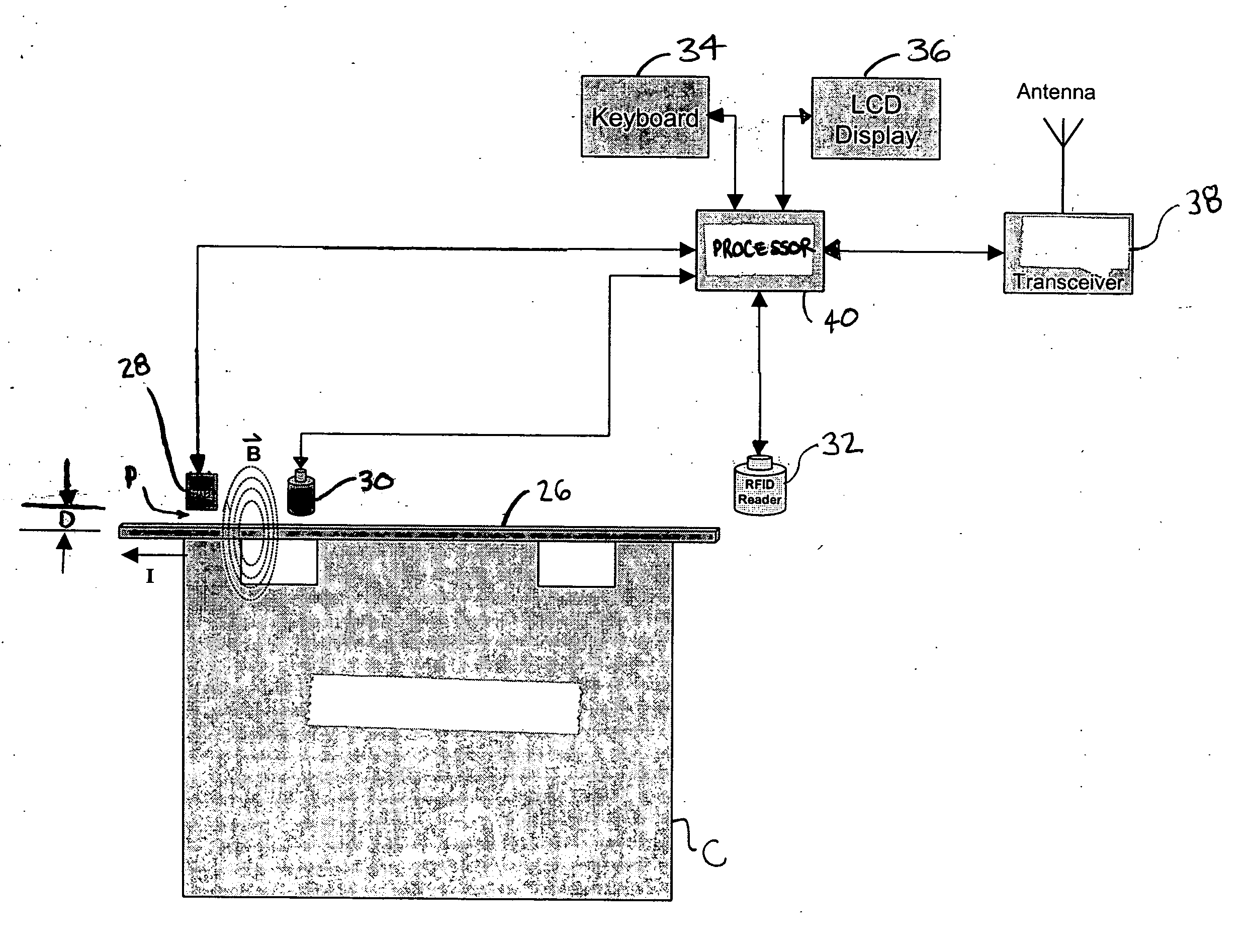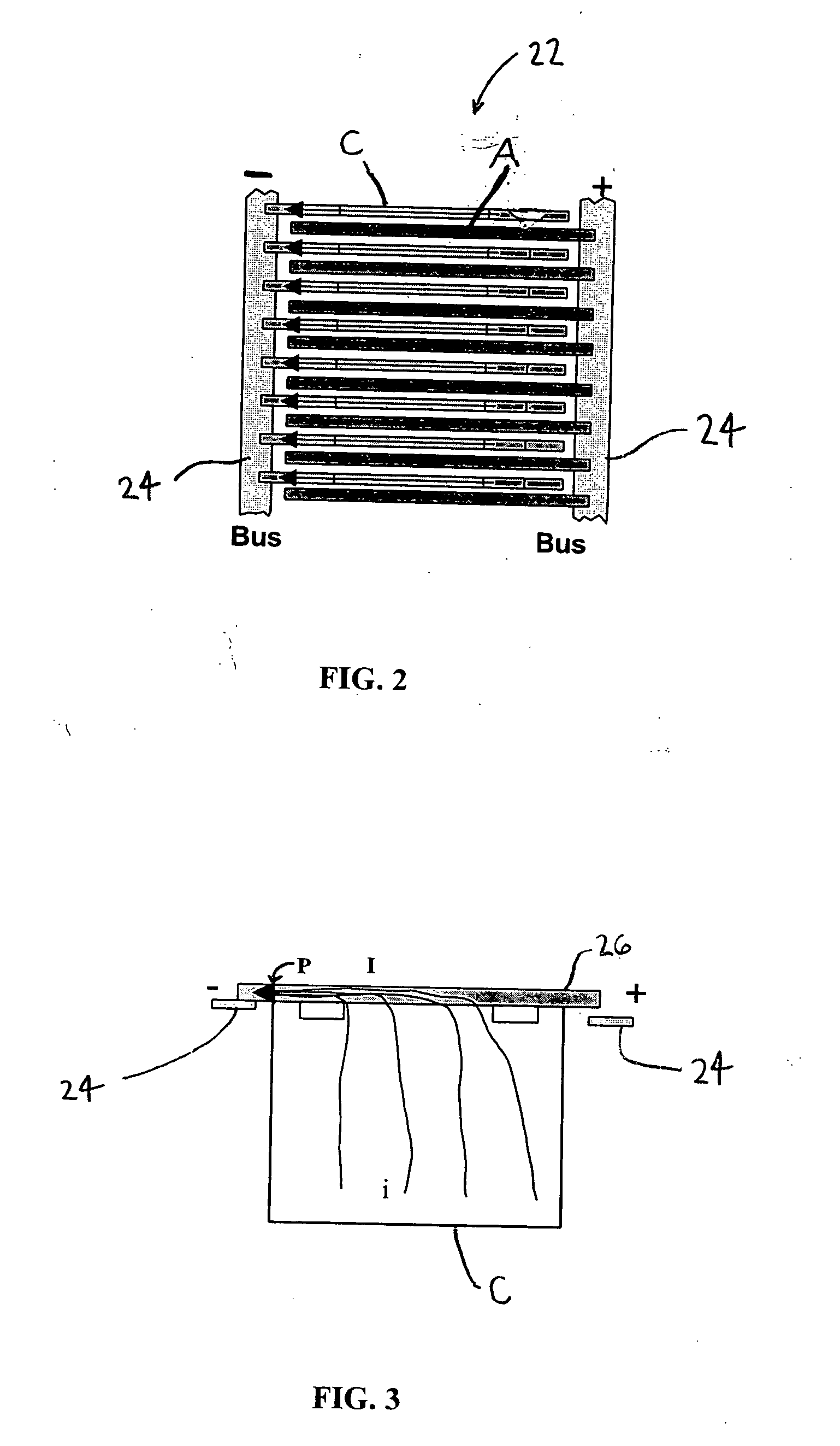Monitoring electrolytic cell currents
a technology of electrolytic cells and current monitoring, applied in the direction of voltage/current isolation, electrolysis components, instruments, etc., can solve the problems of short circuits, reduced efficiency of electrical use, and disruption of copper plating process, so as to improve electrode quality and increase energy utilization and efficiency
- Summary
- Abstract
- Description
- Claims
- Application Information
AI Technical Summary
Problems solved by technology
Method used
Image
Examples
second embodiment
[0088] More specifically, FIGS. 12-13 depict a pole device 52 according to the invention, in which a Hall Effect sensor array 54 incorporates one or more Hall Effect sensors 28, preferably one Hall Effect sensor 28 for each cathode C of each electrolytic cell 22, thereby enabling simultaneous measurement of multiple cathodes C, including, for example, all of the cathodes C of the electrolytic cell 22.
[0089] In such an embodiment, the Hall Effect sensor array 54 may be connected to a processing head 56 for processing data therefrom, the processing head 56 containing one or more of the keyboard 34, LCD display 36 or the like, transceiver 38, or the processor 40 (not shown).
[0090] In addition, the Hall Effect sensor array 54 may also include one or more LEDs 58 associated with the Hall Effect sensor 28 for visually indicating the status of the electrolytic cell 22 being monitored. For example, a first (e.g. red) LED could indicate the presence of a short circuit while a second (e.g., ...
third embodiment
[0091] Likewise, FIG. 14 depicts a rail car device 58 according to the invention, in which the Hall Effect sensor array 54 incorporates one or more Hall Effect sensors 28, preferably one Hall Effect sensor 28 for each cathode C of each electrolytic cell 22, thereby enabling simultaneous measurement of multiple cathodes C, the Hall Effect sensor array 54 carried by the rail car device 58 along a pair of rails 60 or the like and connected to the processing head 56 for processing data therefrom.
fourth embodiment
[0092] According to the invention (not shown), an overhead crane, robotic, or other device can also carry out the inventive arrangements, in which the Hall Effect sensor array 54 incorporates one or more Hall Effect sensors 28, preferably one Hall Effect sensor 28 for each cathode C of each electrolytic cell 22, thereby enabling simultaneous measurement of multiple cathodes C, the Hall Effect sensor array 54 carried by the overhead crane, robotic, or other device and likely connected to a processing head 56 for processing data therefrom.
[0093] As described, those skilled in the art will recognize that many of the inventive arrangements can be realized in hardware, software, firmware, or any various combinations thereof. Moreover, any kind of processor 40, or other apparatus, adapted for carrying out the inventive arrangements described herein is suited. A typical combination of hardware and software, for example, could be a general purpose microprocessor chips (e.g., MPU) with a com...
PUM
| Property | Measurement | Unit |
|---|---|---|
| weight percent | aaaaa | aaaaa |
| distance | aaaaa | aaaaa |
| distance | aaaaa | aaaaa |
Abstract
Description
Claims
Application Information
 Login to View More
Login to View More - R&D
- Intellectual Property
- Life Sciences
- Materials
- Tech Scout
- Unparalleled Data Quality
- Higher Quality Content
- 60% Fewer Hallucinations
Browse by: Latest US Patents, China's latest patents, Technical Efficacy Thesaurus, Application Domain, Technology Topic, Popular Technical Reports.
© 2025 PatSnap. All rights reserved.Legal|Privacy policy|Modern Slavery Act Transparency Statement|Sitemap|About US| Contact US: help@patsnap.com



